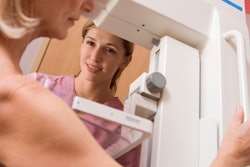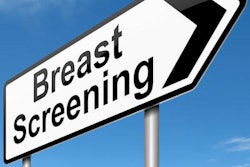
Mammography screening is associated with a 28% decrease in risk for breast cancer cases with a tumor size greater than 21 mm, according to an Austrian population study. Results also demonstrated a 17% decrease in risk for advanced breast cancer.
The researchers examined cancer characteristics of women residing in the Austrian state of Tyrol, looking specifically at breast cancer cases exposed to screening versus those unexposed to screening. The research team, led by Dr. Willi Oberaigner from the clinical epidemiology department of Tirol Kliniken, Cancer Registry of Tyrol in Innsbruck, found statistically significant differences in the two groups.
"In our registry analysis, we observed that participation in the mammography screening program in Tyrol was associated with important risk reductions for advanced breast cancer by 17%, for breast cancer with tumor size greater than 21 mm by 28%, and for metastatic breast cancer by 73%," the team wrote (Breast, June 2017, Vol. 33, pp. 178-182). "We, therefore, expect that the Tyrolean mammography program will lead to a relevant reduction in breast cancer mortality."
Stage shift
Breast cancer screening often is embroiled in controversy. However, the proponents who argue for the validity of breast cancer screening as a cancer reduction method state one of the main reasons for mortality reduction is stage shift: Mammography screening leads to a shift toward earlier breast cancer stages, and women with an earlier stage experience better survival than do those with advanced stage.
Some previous researchers have found an inverse association between the proportion of advanced breast cancer cases detected in a screening program and the expected mortality reduction as a consequence of participating in a mammography screening program.
"To estimate whether our program could result in a breast cancer mortality reduction, we used the advanced cancer rates in the exposed and unexposed to screening groups as a surrogate measure of the forthcoming mortality reduction," Oberaigner and colleagues wrote.
They linked the database with all incident breast cancer cases diagnosed in Tyrol and the screening database, making it possible to characterize cases diagnosed between 1 January 2009 and 31 December 2013. In particular, they looked for a shift in advanced breast cancer for the group exposed to screening compared with the group unexposed to screening.
Due to the time period, the screening program used in the Austrian study is a regional one -- it wasn't until 2014 that Austria launched a national, population-based screening program.
In Tyrol, women 40 to 59 years old were invited annually and women 60 to 69 years old were invited biennially. In about 145,000 women, 1,475 invasive breast cases were registered. The researchers estimated an age-adjusted relative risk (RR) of 0.72 for tumor size greater than 21 mm, 0.27 for metastatic breast cancer, and 0.83 for advanced breast cancer, comparing those exposed with those unexposed to screening, respectively.
| Characteristics of invasive breast cancer | |||
| Exposed to screening | Unexposed to screening | Age-related relative risk | |
| Tumor size < 21 mm | 647 | 289 | 2.09 |
| Tumor size ≥ 21 mm | 215 | 280 | 0.72 |
| Tumor size missing | 12 | 32 | -- |
| No advanced breast cancer | 544 | 226 | 2.25 |
| Advanced breast cancer | 323 | 367 | 0.83 |
The researchers found statistically significantly less advanced breast cancer, fewer breast cancer cases with a tumor size greater than 21 mm, and fewer metastatic breast cancer cases in the group exposed to screening.
How this study compares
Several studies have been published that cover various aspects of breast cancer characteristics associated with mammography screening. Most of these analyses compare estimates of the number of early breast cancer cases between a prescreening period and a screening period. However, these temporal pattern studies looking at incidence of early- or late-stage breast cancer are prone to a number of methodological challenges, especially those dealing with the underlying time trend in breast cancer incidence in the absence of screening, the participation rate of the screening program, the length of observation period, the stage migration bias, and the statistical methods, according to the authors.
For instance, some of the previous studies of the time trend of advanced breast cancer incidence demonstrate a decrease in advanced breast cancer incidence between 10% and 20% -- for example, in the U.S., Italy, the U.K., Finland, the Netherlands, Australia, and Germany. However, a number of studies show a relatively stable time trend for incidence of advanced breast cancer -- for example, in the Netherlands, Switzerland, and some Norwegian counties.
"The main strength of our study is the fact that we were able to link register and screening data on a personal basis and consequently categorize all incident breast cancer cases by screening attendance," the authors wrote. "A second strength is the cancer registry's full coverage and the fact that nearly complete data on cancer characteristics was obtained."
One study limitation is the lack of data needed to adjust for confounding and various potential biases, especially lead time bias because the analysis was restricted to the first five years of an organized mammography screening program following a period of about 15 of spontaneous screening.
In the future, Oberaigner and colleagues plan to collect more detailed data on breast cancer characteristics, mainly histology and hormonal status, to be able to assess the aggressiveness of tumors in the two screening exposure groups.



















